1996 VOLKSWAGEN GOLF steering
[x] Cancel search: steeringPage 4 of 274
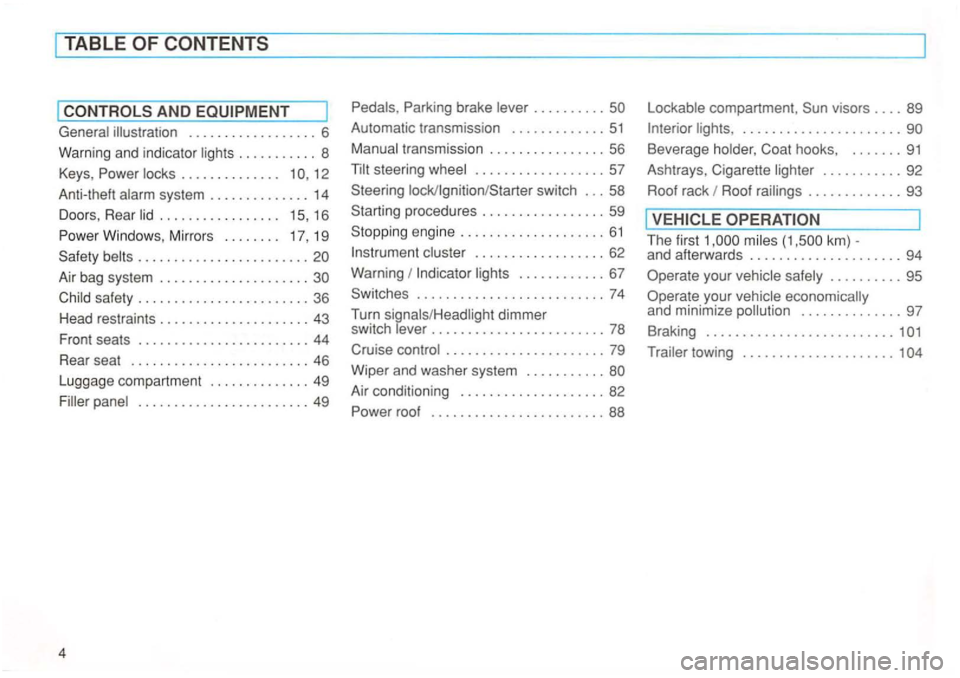
TABLE
brake compartment,
illustration . . . . . . . . . . . . . . . . . . 6 Automatic
transmission ............. 51 ......................
Warning and indicator ........... 8 Coat hooks, ....... 91
Keys, . . . . . . . . . . . . . . 1 12 steering ........... 92
Anti-theft switch ... 58 Roof rack Roof ............. 93
Do ors , R ea r
. . . . . . . . . . . . . . . . . 15, 16
........................
Sta rting procedures ................. 59
S topping engine .
....... ............ 61
.................. 62 T he first km) -
and afterwards ..................... 94
Air bag system
..................... Warning ............ 67 .......... 95
safety ........................ 36
H ea d r estra ints
..................... 43
Front seats
........................ 44
Rear seat
......................... 46
Lugga ge compartm ent
.............. 49
dimmer
switch .................... .... 78
Cruise
Air conditioning .................... 82
4
Page 10 of 274
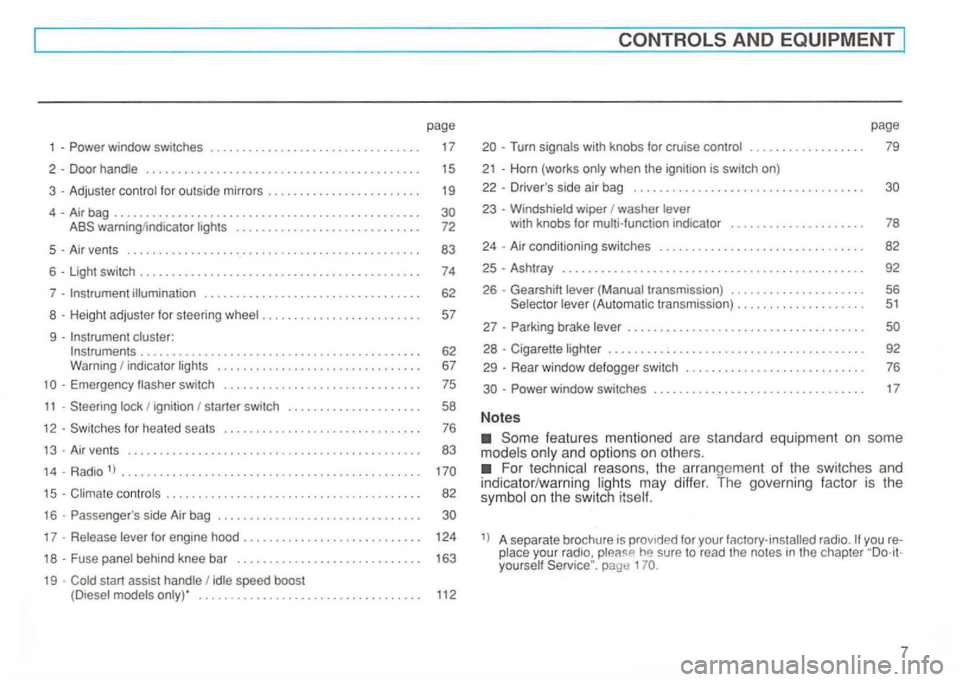
page
window switches . . . . . . . . . . . . . . . . . . . . . . . . . . . . . 17
2 -Door handle . . . . . . . . . . . . . . . . . . . . . . . . . . . . . . . . . . . . . . . . . . . 15
3 -Adjuster control for outside mirrors . . . . . . . . . . . . . . . . . . . . . . . . 19
4 -Air bag . . . . . . . . . . . . . . . . . . . . . . . . . . . . . . . . . . . . . . . . . . . . . . . . . . . . . . 72
5 -Air vents . . . . . . . . . . . . . . . . . . . . . . . . . . . . . . . . . . . . . . . . . . . . . . 83
6 -Light switch . . . . . . . . . . . . . . .. .. . . . .. .. . . . . . . . . . .. . . . . . . . . 7 4
7 -
illumination . . . . . . . . . . . . . . . . . . . . . . . . . . . . . . . . . . 62
8 -Height adjuster for steering wheel . . . . . . . . . . . . . . . . . . . . . . . . . 57
9 -
cluster: . . . . . . . . . . . . . . . . . . . . . . . . . . . . . . . . . . . . . . . . . . . . 62 Warning indicator lights . . . . . . . . . . . . . . . .
-Steering lock ignition starter switch . . . . . . . . . . . . . .
. . . . . . . . . . . . . . 83
14-1
) . . . . . . . .
15 -Climate controls . . . . . . . . . . . . . . . . . . . . . . . . . . . . . . . . . . . . . . . . 82
16 -
side Air bag . . . . . . . . . . . . . . . . . . . . . . . . . . . . . . . .
idle speed boost
( D1esel models . . . . . . . . . . . . . . . . . . . . . . . . . . . . . . . . . . . 112
-Turn signals with knobs for cruise control ................. .
21 -Horn (works only when the ignition is switch on)
22 -Driver 's side air bag ................................... .
23 -Windshield wiper washer lever
w ith knobs for multi -function indicator .................... .
24 -Air conditioning switches ...............•........•.......
25 -Ashtray .............................•.................
26 -Gearshift lever (Manual transmission) .................... .
Selector lever (Automatic transmission) ............... .... .
27 -
29 -Rear window defogge r switch ................•...........
-
78
82
92
56 51
For technical reasons, the arrangement of the switches and
indica to r/warnin g lig hts may differ. The govern ing factor is the symbol on the sw itch itself.
1
) A separate brochure is prov1ded for your you place your radio , yourself Service".
7
Page 16 of 274
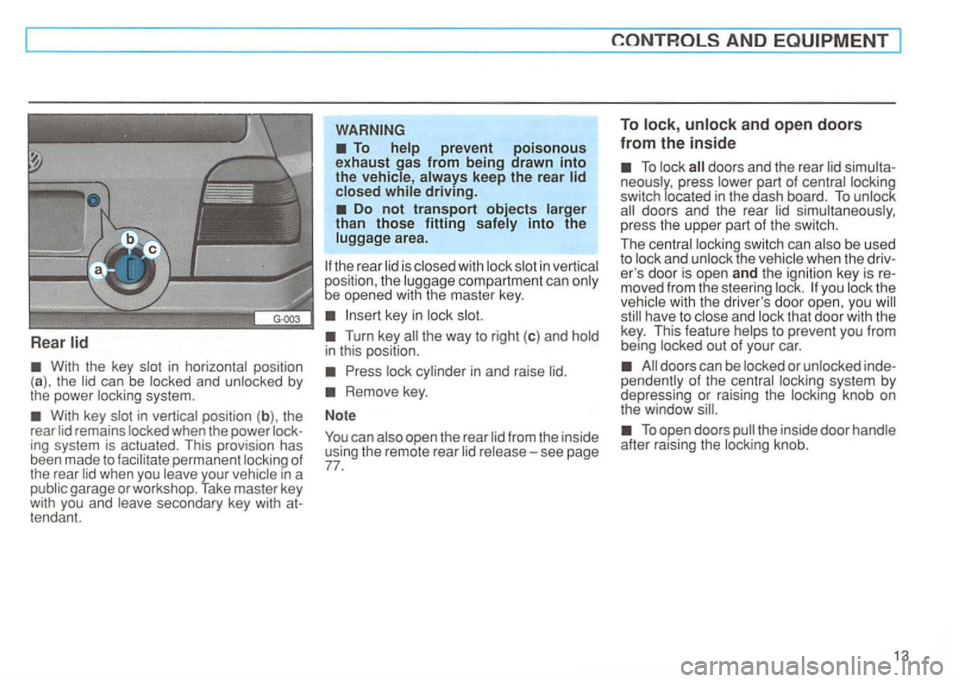
Rear
in ho rizontal position
(a) , the ca n be locked and unl ocked by the power locking system.
remains locked when the power ing system is actuated. This provision has
been made to facilitate permanent locking of
the rear in a
public garage or workshop. Take master key
with you and
tendant.
To
closed while driving.
Do not transport objects larger
than those safely into the
luggage area.
key in
Turn key in this position.
Press cylinder i n and raise
can
and open doors
from the inside
To doors and the rear part of central locking
switc h loc ated in the dash board . To unlock doors and the rear simulta neous ly, press the upper part of the switch.
Th e central lo cking switch can
be used to lock and un lock the vehicle when the
moved from the steering you the
ve hicl e with th e driver 's do or ope n, yo u that doo r with the key. This feature to preve nt you from
being locked out of your car.
pende ntly of the central locking system by
d epressi ng or raising the locking knob on
the window
To open doors
Page 24 of 274
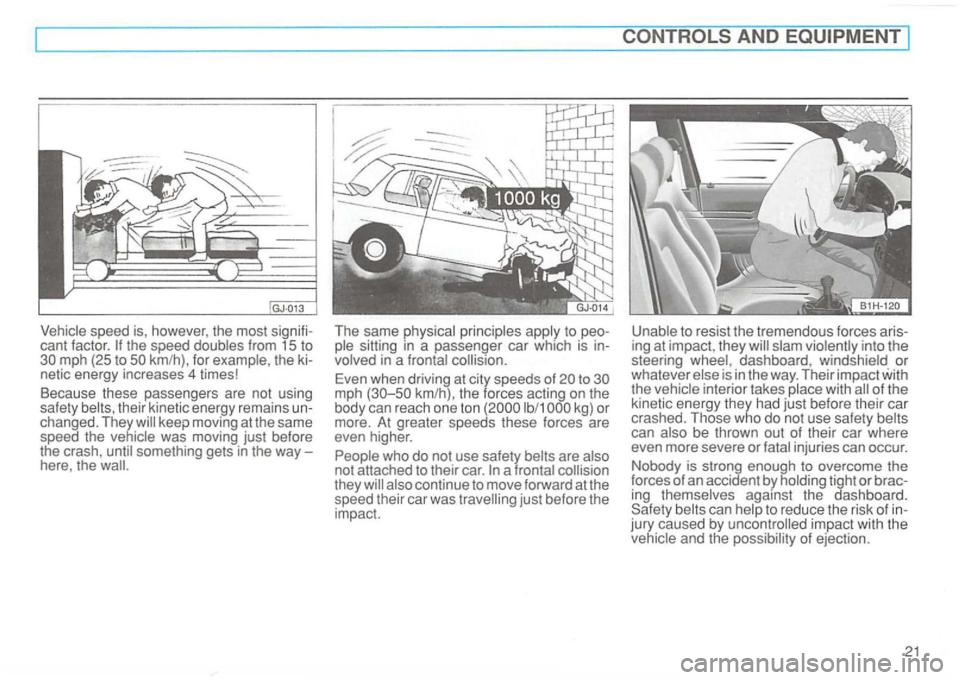
Vehicle speed is, however , the most signifi
cant factor. the speed doubles from 15 to
km/h), the forces acting on the
body can reach one ton lb/1 kg) or
more. At greater speeds these forces are
even higher.
a frontal collision
they will also continue to move forward at the
speed their car was travelling just before the
impact.
Unable to resist the tremendous forces aris
ing at impact , they will slam violently into the
steering wheel, dashboard, windshield or
whatever else is in the way. Their impact
Page 33 of 274
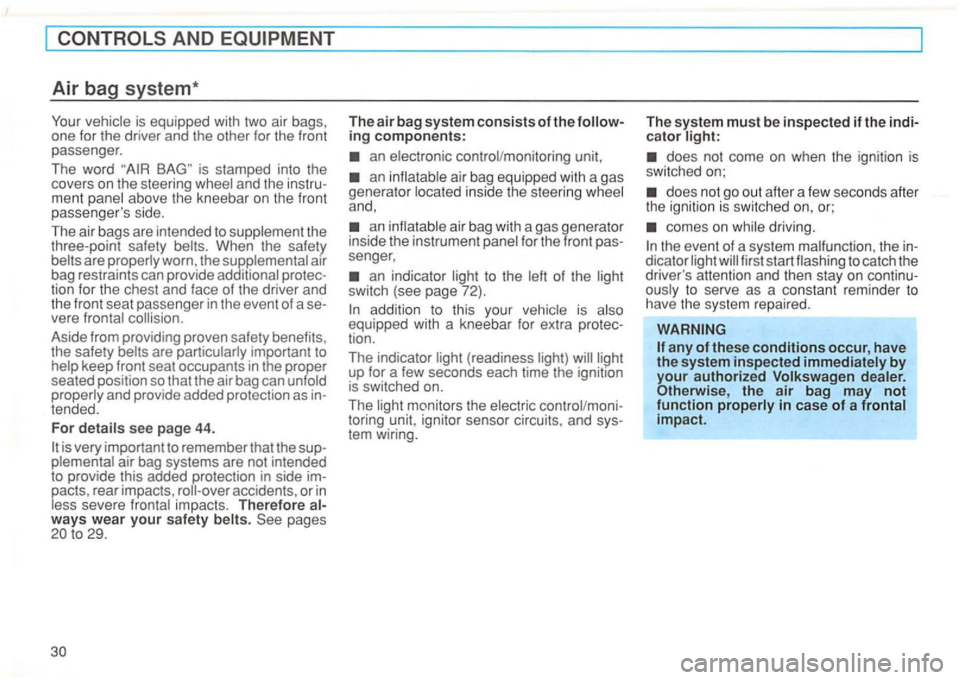
AND
is stamped into the
covers on the stee ring wheel and the instru
ment panel above the kneebar on the front
passenger 's side.
The air bag s are intended
to supplement the
three-point safety belts. When the sa fety
belts are properly worn, the supplemental air
bag resiraints can provide additiona l protec
tion for the chest and
face of the driver and
the front seat passe nger in the even t o f a se
vere frontal collision.
Aside from providing proven safety benefits ,
the safety belts are particularly important to
help keep front seat occupants in the proper
seated position so that the air bag can unfold
prope rly and provide added protection as in
tended.
Fo r
details see page 44.
The air bag system consists of the following components:
an electron ic control /mon itoring unit,
an inflatable air bag equipped with a gas
genera tor located inside the steering wheel
and,
an inf latable air bag with a gas generator
inside the instrument panel for the front pas
sen
ger,
an indicator light to the left of the light
swi tch (see page 72).
addition to this your vehicle is also
equipped with a kneebar for extra protec
tion.
The indicator light (readi ness light) will light
up for a few seconds each time the ignition
is switched on.
The light monitors the electric control/mon i
toring unit, ignitor sensor circuits, and sys
tem wiring. The
system must b
e inspected if the indi
c ator light:
comes on while drivi ng.
any of these conditions occur, have the system inspected immediately by your authorized Volkswagen dealer. Otherwise, the air bag may not function properly in case of a frontal impact.
Page 35 of 274
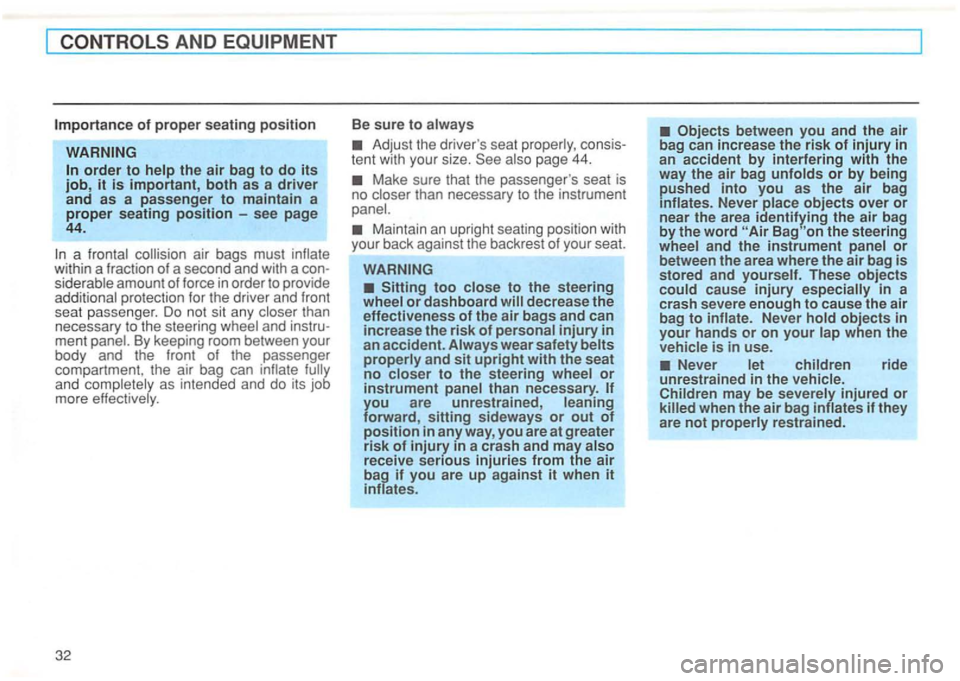
AND
the air bag to do its job, it is important, both as a driver and as a passenger to maintain a proper seating position -see page 44.
a frontal
siderable amount of force in order to provide
ad ditional protection for the driver and front
seat passe nger . Do not sit any
and ment
tent with your size. See page 44.
Make sure than necessary to the instrument
Objects between you and the air
bag can increase the risk of injury in
an accident by interfering with the
way the air bag unfolds or by being
pushed into you as the air bag
inflates. Never
the steering or between the area where the air bag is stored and yourself. These objects
objects in your hands or on your when the
vehicle is in use.
may be severely injured or
Page 37 of 274
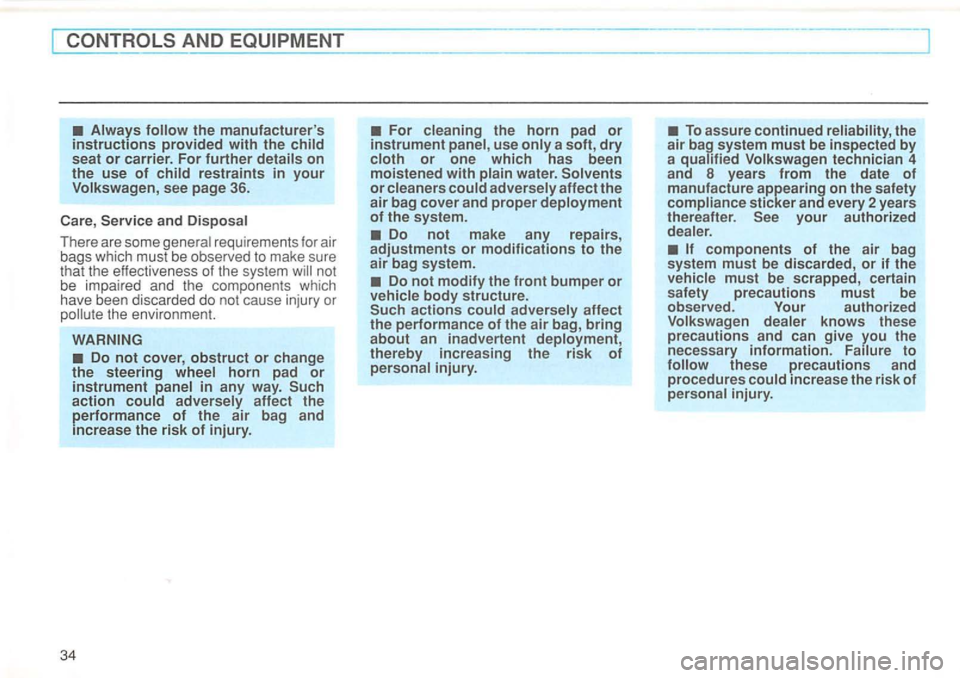
AND
requirements for air
bags which must be obse rved to make sure
t h at the effectiveness of the system not
b e impai re d and th e components which
have been discarded do not cause injury
or
Do not cover, obstruct or change
the steering horn pad or instrument affect the
performance of the air bag and
increase the risk of injury.
34
For the horn pad or instrument use a soft, dry
of the system.
Do not make any repairs ,
adjustments or modifications to the
air bag system.
Do not modify the front bumper or
thereby increasing the risk of
To assure continued the
air bag system must be inspected by
a
sticker and every 2 years
thereafter.
to
Page 47 of 274
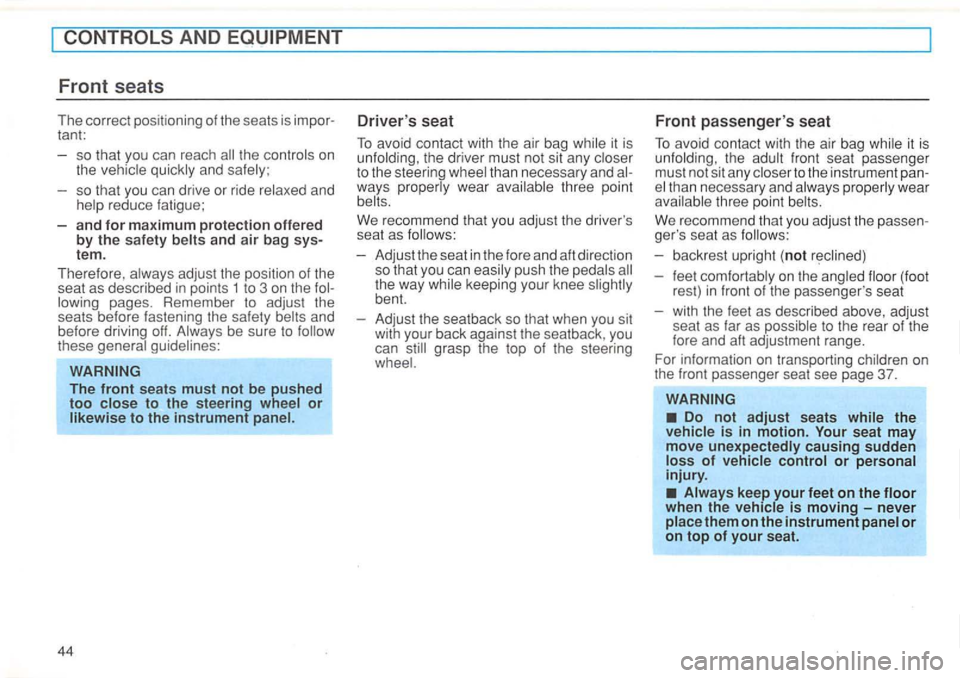
AND
tant: so that you can reach
the controls on
the quickly and safely ;
so that you can drive or ride relaxed and
reduce fatigue;
a
nd for maximum p rotec tion offe re d by the sa fety b elts and air bag tem.
T herefore , always adju st the position of the
seat as describ ed in points 1 to 3 on the
lowing pages. Remember to adjust the
seats before fasteni ng the safety belts and
before driving off. Always be sure to
these general guidelines:
to the instrument
44
Driver 's seat
To avoid contact with the air bag while it is
unfolding , the driver must not sit any
to the steering wheel than necessa ry and ways properly wear
the way while keeping your knee bent.
Adjust the seatback so that when you sit
with your back against the seatback , you
can
grasp the top of the steering
Fron t passenger 's seat
To avoid contact with the air bag while it is
unfo ld ing , the adult fr ont seat passenger
must not sit any closer to the instrument
el than necessary and always properly wear
avai lable three point
We recommend that you adjus t the
- backrest upright (not
-feet comfortab ly on t he angled floor {foot
re st) in front of the passenger 's seat
- with the feet
as descr ibed above , adjust
seat as far as possible to the rear of the
for e and aft adjustment range.
For information on trans porting children on
the front passenger seat see page 37.
Do not adjust seats